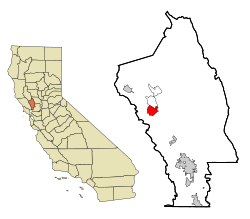Saint Helena, California
|
City of St. Helena Anakotanoma |
||||||||
|---|---|---|---|---|---|---|---|---|
| General law city | ||||||||
Clockwise from top: the business district, the former train station, the Richie Block building, St. Helena High School, the fire station, and the post office.
|
||||||||
| Motto: "Napa Valley's Main Street", "The Heart Of Napa Valley" | ||||||||
 Location in Napa County and the state of California |
||||||||
| Coordinates: 38°30′19″N 122°28′13″W / 38.50528°N 122.47028°W | ||||||||
| Country | United States | |||||||
| State | California | |||||||
| County | Napa | |||||||
| Incorporated | March 24, 1876 | |||||||
| Re-incorporated | May 14, 1889 | |||||||
| Government | ||||||||
| • Type | Council-City Manager | |||||||
| • Mayor | Alan Galbraith | |||||||
| • Vice mayor | Peter White | |||||||
| • City manager | Jennifer Phillips | |||||||
| Area | ||||||||
| • City | 5.027 sq mi (13.019 km2) | |||||||
| • Land | 4.986 sq mi (12.913 km2) | |||||||
| • Water | 0.041 sq mi (0.106 km2) 0.81% | |||||||
| Elevation | 253 ft (77 m) | |||||||
| Population (April 1, 2010) | ||||||||
| • City | 5,814 | |||||||
| • Estimate (2013) | 5,947 | |||||||
| • Density | 1,200/sq mi (450/km2) | |||||||
| • Metro | 136,484 | |||||||
| Time zone | Pacific (UTC-8) | |||||||
| • Summer (DST) | PDT (UTC-7) | |||||||
| ZIP code | 94574 | |||||||
| Area code | 707 | |||||||
| FIPS code | 06-64140 | |||||||
| GNIS feature IDs | 277588, 2411758 | |||||||
| Website | www |
|||||||
St. Helena (/ˌseɪnt hᵻˈliːnə/ saint hə-LEE-nə) (Wappo: Anakotanoma, "Bull Snake Village") is a city in Napa County, California. It is part of the North Bay region of the San Francisco Bay Area. The population was 5,814 at the 2010 census.
The city's American Viticultural Area includes 416 vineyards encompassing 6,800 acres (2,800 ha) of planted vineyards. St. Helena is also the location of The Culinary Institute of America at Greystone and a campus of Napa Valley College.
Ellen White, co-founder of the Seventh-day Adventist Church, had a home called "Elmshaven" near St. Helena, beginning in 1900. She died there in 1915 and the site is now a National Historic Landmark. Both the Beringer Vineyards and the Charles Krug Winery are California Historical Landmarks.
...
Wikipedia






